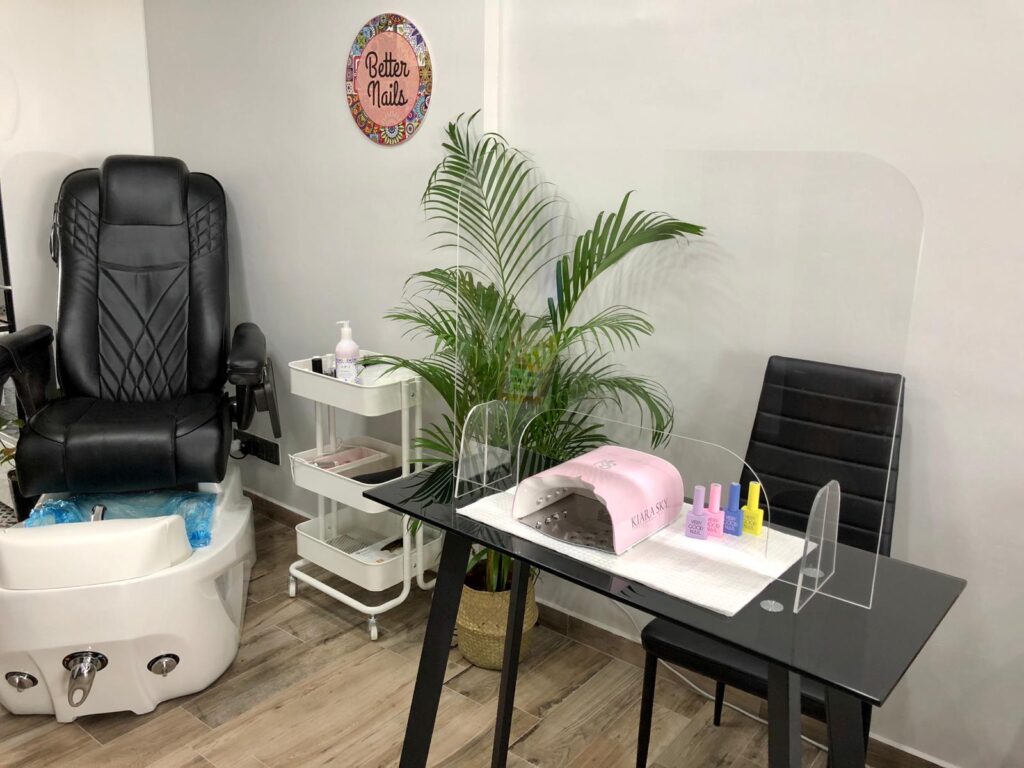Manicure and Pedicure sessions are a relaxing treat and who doesn’t love beautiful nails. What comes to mind when you think of nail salon hygiene though? Here’s a quick list of hygiene practices that you can observe when you’re checking out a new salon.

1. Note the Salon/Studio’s Overall Cleanliness
The nail salon is essentially a shared workspace, not just between nail techs but also between clients. As such, it’s important to maintain a clean and hygienic working environment in order to prevent the spread of infectious diseases and bacteria.
Note if there are any strong odours. This is particularly relevant for nails that work with acrylic. Acrylic fumes have the potential to cause dizziness and headaches, especially with prolonged exposure. This puts the nail tech at a greater risk that clients. However, this risk can be mitigated by having a well-ventilated salon environment.
Is the table and floor clean? During gel and acrylic removal, dust is often produced because of the e-filing process. In addition, during callus and dead skin removal, these need to be deliberately cleaned up. However, in a busy nail salon, nail techs may neglect to do so. If you notice this, you should request for a proper wipe down of the shared spaces before starting your treatment.

2. Take Note of the Pedicure Foot Basins
Pedicure foot baths, especially those with water jets are really therapeutic for tired feet. However, it would be good to note the type of pedicure foot basins used. There are two main types of pedicure chairs, pipe-less pedicure chairs, and those with pipes.
It’s quite self-explanatory, some pedicure chairs use pipes for water circulation while pipe-less pedicure chairs use other means to circulate water, for example through magnetic water jets. Pedicure chairs with pipes are much harder to clean because bacteria from a client’s feet could remain within the pipes. The proper disinfection process would typically require the use of barbicide, a disinfectant solution used by barbers and cosmetologists for disinfecting grooming tools.
Pipe-less pedicure chairs are easier to clean because there are no hidden pipes to be concerned with. However, it is still necessary to clean and disinfect all parts that are immersed in the water basin. Otherwise, bacteria can spread between clients.
Are disposable liners used? This acts as an extra layer of protection for clients, ensuring that the water used during treatment and the feet basin surface are clean. However, not all salons use this.

3. Are Disposable tools discarded properly?
Nail tools that are disposable include nail files and cotton wool. Some nail files are designed to be used more than once. This is fine although such tools need to be throughly scrubbed to remove dead skin, and then disinfected, e.g. using a UV steriliser.
In general, nail equipment should not be directly placed in the UV steriliser because there may be residual skin flakes or dust which may block the UV rays and prevent complete coverage of the equipment being sterilised.

4. Observe the Disinfection Process
In this post Covid-19 world, most businesses and people should be much more aware of good hygiene practices. Whether or not these are practiced is another matter.
When you enter the salon, are you asked to wash your hands or at least use a hand sanitiser? Sanitising the hands before entering the salon/studio should is essential because you don’t know where a client’s hands have been so it’s necessary to kill any viruses before they have a chance to spread into the nail salon.
Do the nail techs wipe down the shared spaces? This includes the pedicure chair, manicure table and even the waiting area. Otherwise, this could also cause cross-contamination between clients.
How does the nail salon disinfect nail tools? An autoclave is a tried and proven way to sterilise nail tools. It relies on high temperature to kill bacteria and viruses and is used in hospitals. However, not many salons use it as it can be expensive. More commonly used methods include the UV steriliser, alcohol-based disinfectants, or barbicide. What is the condition of such equipment?
One way that you can be sure is to use buy and bring your own set of nail tools to the nail salon.

5. Do the Nail Techs Wear Masks and Gloves?
In the post-Covid-19 world that we’re in, this may seem obvious. However, even without the outbreak of Covid-19, nail techs should be using surgical masks and gloves.
Surgical masks serve two purposes, to protect the nail tech from inhaling fine dust particles during gel and acrylic removal. It also helps prevent the spread of viruses spread through saliva (eg. flu).
Gloves are also important because the nail tech may work on many clients in one day and hence new gloves should be used for each client to prevent the spread of any diseases.

Conclusion
Nail salon hygiene is quite similar to workplace safety, it is something that is often overlooked and underestimated. That is, until something serious happens. In the case of nail salons, this could be a bad nail infection.
So to protect your nails and keep them healthy and pretty, take a mental note of the next salon/studio you visit! When you visit a professional nail salon/studio that has good hygiene practices, you don’t have to worry about any of this and can focus on choosing your next nail art design.

Better Nails Studio is a boutique home-based nail studio that is run by Lan, who has more than 4 years of professional working experience in Sydney nail salons. At Better Nails, clients can rest assured that good hygiene practices are strictly observed. The only thing you’ll have to be concerned about is….what nail art you would like!